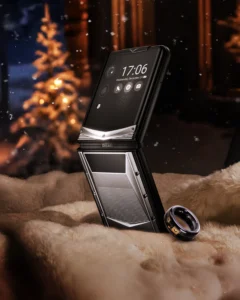
In a world where our smartphone is our most personal device, the one-size-fits-all approach is becoming a thing of the past. The demand for a Customizable Smartphone is about more than just changing your wallpaper or ringtone; it's about tailoring the device to your unique workflow, aesthetic preferences, and functional needs. In 2025, the ability to personalize your phone's software and even some hardware elements is a key differentiator in a crowded market.
This guide will walk you through what it means to have a truly customizable smartphone, which devices lead the pack, and how you can transform your phone from a generic gadget into a perfect digital extension of yourself.
What is a Truly Customizable Smartphone?
A clear definition of a customizable smartphone
A Customizable Smartphone is a device that offers users extensive control over its software interface and functionality, well beyond the basic settings. This includes the ability to change the home screen launcher, install system-wide icon packs, create deeply integrated widgets, remap hardware buttons, and alter the entire look and feel of the operating system. At its core, it's about empowering the user to make the device work for them, not the other way around.
What are the main advantages of a customizable phone?
The primary benefits are enhanced productivity and deep personalization. By arranging apps, shortcuts, and information widgets exactly how you want them, you can create a more efficient workflow. Aesthetically, you can design a user interface that reflects your personal style. For users with specific accessibility needs, customization allows for larger icons, high-contrast themes, and simplified layouts, making the device significantly easier to use.
Why does customization matter in today's market?
In a market where many phones share similar hardware specifications, the software experience is what sets them apart. A highly customizable operating system creates a stronger bond between the user and their device, fostering a sense of ownership. It allows a single piece of hardware to serve a wide range of users—from the minimalist who wants a clean interface to the power user who needs information-dense widgets and custom shortcuts.
How to Get Started with Smartphone Customization
What are the essential requirements?
The most important requirement is choosing the right platform. Android is the undisputed champion of customization due to its open-source nature. To get started, you only need your phone and access to the Google Play Store, which is home to thousands of launchers, icon packs, and widget tools. On the iOS side, while more restricted, you'll need a modern iPhone running the latest version of iOS to take advantage of its growing list of personalization features like Lock Screen widgets and Focus Modes.
What are the first steps to customizing my phone?
-
Choose a Third-Party Launcher (Android): This is the single most impactful change you can make. Apps like Nova Launcher, Action Launcher, or Niagara Launcher replace your default home screen, offering immense control over the app grid, icons, gestures, and more.
-
Install an Icon Pack: Find an icon pack on the Google Play Store that matches your desired aesthetic and apply it through your new launcher's settings.
-
Create Custom Widgets: Use apps like KWGT (Kustom Widget Maker) to design your own widgets from scratch, displaying anything from weather and calendar info to your battery status in a style that's uniquely yours.
-
Explore System Settings: Both Android and iOS have built-in options to change fonts, theme colors (like Google's Material You), and screen layouts.
What are the common challenges?
The biggest challenge is the risk of performance impact. Overloading your phone with too many resource-heavy widgets and live animations can lead to slower performance and increased battery drain. For newcomers, the sheer number of options can also be overwhelming. The key is to start small and add new elements gradually.
Best Practices for a Great Custom Experience
-
Prioritize Function Over Form: A beautiful home screen that's difficult to navigate is a bad design. Arrange your layout based on your most frequently used apps and information.
-
Strive for Cohesion: Try to use widgets, icons, and wallpapers that share a similar design language or color palette for a clean, professional look.
-
Avoid Untrusted Sources: Only download customization apps from official sources like the Google Play Store or Apple App Store to protect yourself from malware.
-
Don't Overdo It: A cluttered screen with dozens of icons and widgets can be distracting and inefficient. Sometimes, a minimalist approach is the most effective.
The Top Customizable Smartphones of 2025
While most Android phones are customizable, some offer more powerful tools and unique features than others.
-
Samsung Galaxy S25 Ultra: Running One UI, Samsung's software is a powerhouse of built-in customization. Its Good Lock app suite is a standout feature, allowing users to deeply modify the lock screen, notification panel, and system navigation beyond what standard Android offers.
-
Google Pixel 10 Pro: The Pixel offers the purest form of Android, making it a perfect “blank canvas.” Its killer feature is Material You, an advanced theming engine that automatically extracts colors from your wallpaper and applies them across the entire system UI, from buttons to app backgrounds.
-
ASUS ROG Phone 9: Aimed at gamers, this phone provides unparalleled control over performance settings. Users can create per-game profiles to control the CPU, fan speeds, and screen refresh rate. Its Armoury Crate software allows for deep customization of the phone's hardware lighting and performance behavior.
-
Nothing Phone (3): This phone stands out with its unique hardware customization. The Glyph Interface on the back—a series of LED light strips—can be customized to serve as a notification light for specific contacts, show charging progress, and more, blending hardware and software personalization.
2025 Customizable Smartphone Comparison
| Feature | Samsung Galaxy S25 Ultra | Google Pixel 10 Pro | ASUS ROG Phone 9 | Nothing Phone (3) |
| Operating System | One UI (based on Android) | Stock Android | ROG UI (based on Android) | Nothing OS (based on Android) |
| Key Customization Feature | Good Lock app suite for deep system modification. | Material You dynamic theming engine. | Armoury Crate for performance and hardware tuning. | Glyph Interface for hardware light notifications. |
| Ideal Customizer | The tinkerer who wants to control every detail. | The minimalist who values aesthetic cohesion. | The power user who wants to control performance. | The designer who values unique hardware integration. |
| Learning Curve | High (due to the sheer number of options in Good Lock). | Low (most customization is automatic or intuitive). | Medium (focused on performance metrics). | Low (focused on a few key features). |
Who Is This For?
A highly customizable smartphone is perfect for:
-
Productivity Power Users: Individuals who want to tailor their device for a hyper-efficient workflow with custom gestures, widgets, and shortcuts.
-
Creatives and Aesthetes: Users who see their phone as a form of self-expression and want to control every visual element.
-
Tech Enthusiasts: People who love to tinker with settings, try new apps, and push their devices to the limit.
-
Users with Accessibility Needs: Anyone who can benefit from the ability to radically change font sizes, icon layouts, and color contrast to make their phone easier to use.
Frequently Asked Questions (FAQ)
1. Does customizing my Android phone void the warranty?
No. Standard software customization, such as using third-party launchers, icon packs, or widgets from the Google Play Store, is perfectly safe and will not void your warranty. The only action that typically voids a software warranty is “rooting,” which involves gaining administrator-level access to the core system files.
2. Which is more customizable, Android or iOS?
Android is fundamentally more customizable than iOS. Its open nature allows apps to change core components of the user interface, like the home screen launcher. While Apple has added more personalization features to iOS in recent years (like Lock Screen customization), it still operates within a more controlled ecosystem without the deep, system-wide modification capabilities of Android.
3. Can heavy customization slow down my phone or drain the battery?
Yes, it is possible. A poorly optimized launcher, multiple widgets that are constantly refreshing data in the background, or complex live wallpapers can consume more CPU resources and, consequently, drain your battery faster. The key is to be mindful of the customizations you apply and to uninstall any that cause a noticeable drop in performance.








